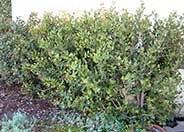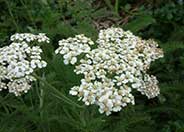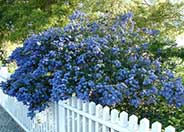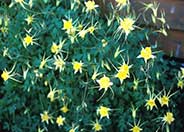
Common name:Lemonade Berry
Botanical name:Rhus integrifolia
The Lemonade Berry is an evergreen shrub that reaches 30' high. It has aromatic leaves and develops small white to pink flowers and red berries. This shrub grows best in coastal areas and is drought tolerant. The Lemonade Berry is a native to California

Common name:California Poppy, Golden Poppy
Botanical name:Eschscholzia californica
This small annual (sometimes acts as a perennial) plant will grow to less than 1' tall and has light, small blue green leaves with gold and orange flowers that bloom in spring and summer.

Common name:Yarrow
Botanical name:Achillea millefolium
This Achillea features spreading mats of fern-like rosettes, along with deeply divided leaves of a green or gray green color. In this form, the flowers are usually a white tone. Stems can reach 1'-2' above foliage, with flower clusters above foliage. Yarrows propagate easily from rooted cuttings or division, which should be performed in the early spring or fall. Following bloom, one should dead head the plant and divide the clumps when it appears crowded.
Maintenance Tips
Achillea millefolium is a flowering perennial that is often referred to as Yarrow. This native variety can develop a dense matt of foliage 1-2’ tall and 3’ wide with large clusters of flowers that stand another 12” above the foliage. This is an aggressive grower, so the best way to keep it low maintenance is to plant it in full sun, well-drained soil, and give it the space it needs to reach its mature size. Deadheading spent blooms is the key to a long blooming cycle. As the flowers fade, prune them back to the foliage, and new blooms will continue to emerge as long as the weather is warm. When the days are shorter and the wet weather arrives, they will often die back to the ground and go into a short period of dormancy. Pruning out the old foliage that looks mealy will help with airflow and will allow the plant to focus on growing its root system during the winter.
Common name:Concha California Lilac
Botanical name:Ceanothus 'Concha'
Concha is a lilac that grows 4'-8' in height and 12' wide. It has small narrow leaves with intense dark blue flower clusters in spring. It is tolerant of coastal and inland conditions.
Maintenance Tips
Ceanothus ‘Concha’ is a dramatic, evergreen native shrub that sends out dark blue flowers for about 4-6 weeks in the late spring. This is one of the hybrids of the native California Lilac and can reach 4-8' tall and up to 12' wide. It is a large, dense shrub that is drought tolerant once established and can take most soil conditions. To keep the maintenance as low as possible, give this plant the room it needs to reach its full mature size. The amount of space this plant requires is often underestimated, leading to poor pruning habits, like shearing, to control the size. If it is planted in a tight space, it is best to use the thinning method of pruning, cutting off the longest branches to the interior of the plant to allow sunlight in and to allow it to keep a natural shape. Over-watering during the hottest months of the year can lead to both pest and fungal issues. Water infrequently and deeply throughout the year and keep the soil around the base of the plant fairly dry to help discourage pest and disease problems.
Common name:Columbine
Botanical name:Aquilegia hybrids
Coumbine has large, spurred flowers with clear colors of white, lavender, yellow, deep red and pink which are borne on 2 1/2' tall plants. The strikingly beautiful blooms make good cut flowers. They require partial shade or full sun, along with well- drained soil. The colors, however, cannot be chosen.
Designer: Dave Buchanan
Photographer: GardenSoft
Incorporate compost 6" into your soil to retain water, reduce compaction, feed earthworms, and provide valuable nutrients to your plants.
Remove irrigation water and fertilizer from areas where you don't want weeds to grow.